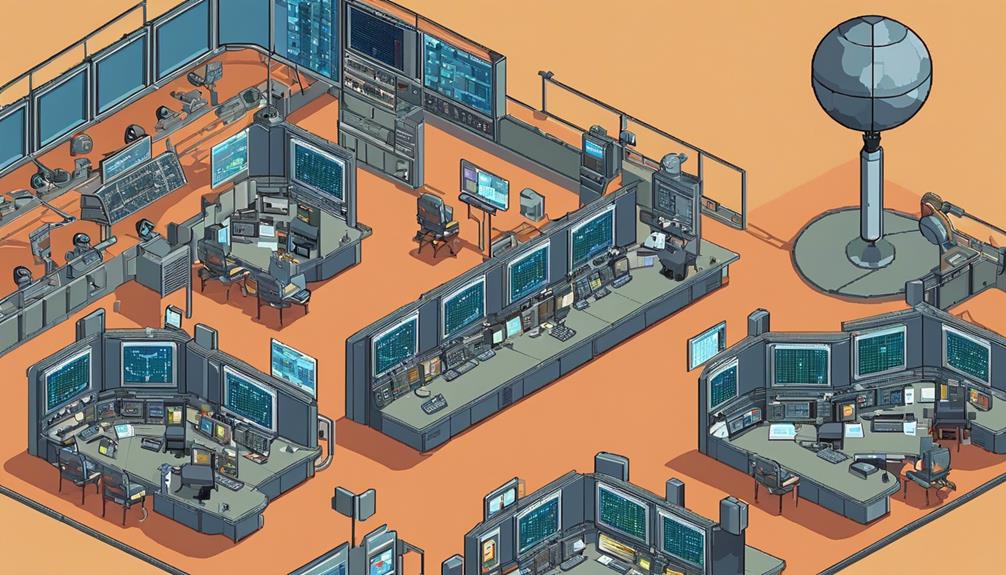The backbone of satellite networks lies within the intricate web of the Control Segment, a vital entity that orchestrates the symphony of GPS satellites' movements and behaviors. From the strategic Master Control Station in Colorado Springs to the silent vigilance of Monitor Stations and the unassuming Ground Antennas, each component plays a unique role in the seamless operation of our global navigation system. But what happens behind the scenes when a satellite drifts off course or a signal falters? The Control Segment holds the answers, making it a nexus of power and precision in the realm of satellite networks.
Key Takeaways
- Master Control Station oversees satellite command and navigation.
- Monitor stations track satellite orbits and system performance.
- Ground antennas enable efficient communication with satellites.
- Control Segment ensures reliability and accuracy of satellite operations.
Overview of Control Segment

The overview of the Control Segment in satellite networks encompasses the essential components, such as the Master Control Station (MCS), monitor stations, ground antennas, and Air Force Satellite Control Network (AFSCN) remote tracking stations that collectively ensure the precision and reliability of satellite operations. The MCS serves as the central hub for satellite command and control, overseeing the health and status of GPS satellites. Sixteen monitor stations strategically located worldwide track GPS satellites by receiving broadcast signals to ensure accuracy and reliability in navigation and timing services. Ground antennas play a pivotal role in facilitating communication with GPS satellites, enabling data uploads, software updates, and error corrections to enhance overall system performance.
Additionally, the AFSCN remote tracking stations, operated by the U.S. Air Force, provide crucial support by collecting telemetry data, tracking satellite orbits, and assisting in anomaly resolution. These remote tracking stations, along with the National Geospatial-Intelligence Agency (NGA) monitor stations, contribute significantly to satellite monitoring and data processing within the control segment. The NGA monitor stations further enhance the network's capabilities by providing additional surveillance and analysis to ensure the integrity and security of satellite operations. Through the coordinated efforts of these components, the Control Segment maintains the operational integrity and functionality of satellite networks, supporting a wide range of critical applications and services reliant on GPS technology.
Role in Satellite Operations
Playing a crucial role in ensuring the precise management and control of GPS satellites' orbits, the Control Segment in satellite networks oversees various operational aspects essential for satellite operations. The Control Segment comprises the Master Control Station (MCS), monitor stations, ground antennas, and remote tracking stations that collectively work to maintain accurate satellite positioning within the GPS constellation. Ground antennas within the Control Segment play a vital role in sending commands and navigation data to satellites, aiding in their operational efficiency.
- The Master Control Station (MCS) is the central hub within the Control Segment responsible for uploading navigation messages and monitoring satellite health.
- Monitor stations are strategically positioned to track satellite orbits, battery recharging, and system performance to ensure optimal functionality.
- Ground antennas serve as communication links, enabling the transmission of commands and data between the Control Segment and the satellites, facilitating precise control and navigation capabilities.
Efforts to modernize the Control Segment aim to enhance GPS accuracy, control capabilities, and overall system performance. By diligently managing the satellites' orbits and operational parameters, the Control Segment plays a pivotal role in ensuring the reliability and effectiveness of satellite operations in a satellite network.
Managing Satellite Health

In overseeing satellite health within a satellite network, the Control Segment diligently monitors critical parameters such as altitude, position, speed, and battery recharging status. This monitoring is crucial for ensuring the proper functioning and performance of satellites in orbit. Monitoring stations within the Control Segment play a vital role in continuously collecting and analyzing data related to satellite health. Ground antennas at these monitoring stations are responsible for uploading navigation and program information to satellites, which aids in maintaining optimal satellite health.
One of the key responsibilities of the Control Segment is anomaly resolution. When anomalies or irregularities are detected in satellite health parameters, the Control Segment takes necessary actions to address and resolve these issues promptly. Additionally, the Control Segment is tasked with updating navigation message parameters to ensure accurate and efficient satellite operations within the designated satellite orbits.
Efforts to modernize the Control Segment are ongoing, with a focus on enhancing satellite health monitoring capabilities and overall satellite performance. By leveraging technological advancements and improvements in monitoring systems, the Control Segment aims to optimize satellite health management for improved operational efficiency and reliability.
Communication With Ground Segment
Facilitating seamless communication between ground antennas and GPS satellites is a critical function of the control segment within a satellite network. Ground antennas play a vital role in ensuring the smooth operation of the satellite system through various activities:
- S-Band Transmissions: Some monitoring stations have ground antennas that enable S-band transmissions to communicate with the satellites efficiently.
- Satellite Health Checks: Ground antennas at specific stations are responsible for conducting thorough satellite health checks both before and after launch to ensure optimal performance.
- Navigation Data Upload: One of the primary functions of ground antennas is to upload navigation and program information to the GPS satellites. This process is crucial for ensuring that the satellites have the necessary data for accurate navigation and operation.
Efficient communication between ground antennas and GPS satellites is essential for maintaining the functionality and accuracy of the satellite network. Furthermore, ongoing modernization efforts are focusing on enhancing the capabilities of the control segment, including improving the efficiency of ground antenna operations. By optimizing communication processes and ensuring reliable data transfer, the control segment can better support the overall performance of the satellite network.
Control Segment Components

The Control Segment Components form the backbone of satellite network operations, encompassing essential elements like the Master Control Station, Monitor Stations, Ground Antennas, and Remote Tracking Stations. These components work in unison to ensure precise satellite positioning, data collection, and command dissemination, underpinning the functionality of the entire segment. Understanding the roles and interactions of these key components is crucial to grasp the overarching control segment operations in satellite networks.
Key Control Elements
Key control elements within the Satellite Network Control Segment encompass the Master Control Station (MCS), Monitor Stations, Ground Antennas, and Remote Tracking Stations. The MCS is the central hub responsible for constellation command, data processing, navigation message generation, and satellite broadcast monitoring. Monitor Stations, equipped with precise atomic clocks, gather GPS data for satellites and enhance system performance. Ground Antennas play a vital role in sending commands and navigation data to satellites, collecting telemetry, and performing S-Band ranging.
- The Master Control Station (MCS) manages constellation command and control.
- Monitor Stations collect GPS data and enhance system performance.
- Ground Antennas send commands and navigation data to satellites.
Segment Functionality Overview
Within the Satellite Network Control Segment, the operational efficiency and effectiveness of the constellation are facilitated through the coordinated functionality of its core components. The Master Control Station (MCS) plays a central role by processing data from global Monitor Stations to generate navigation messages for GPS satellites. Monitor Stations, equipped with atomic clocks, collect crucial GPS data used in navigation message computation. Ground Antennas are essential for sending commands and navigation data to satellites, collecting telemetry, and performing S-Band ranging activities. Additionally, Remote Tracking Stations within the Air Force Satellite Control Network (AFSCN) provide supplementary satellite information to enhance control segment operations, ensuring the seamless functioning of the satellite network.
Satellite Operations Monitoring
Ensuring the seamless operation of satellite networks involves meticulous and continuous monitoring of satellite activities. Monitoring stations play a critical role in overseeing the GPS satellite constellation and maintaining the accuracy of positioning and timing data. Here are three key aspects of satellite operations monitoring:
- Continuous Tracking: Monitoring stations track GPS satellites almost continuously, ensuring that accurate data is constantly available for various applications that rely on satellite positioning and timing information.
- Anomaly Detection: These stations are strategically located to detect any anomalies in satellite behavior promptly. This early detection enables quick responses to address issues and maintain the overall health of the GPS constellation.
- Data Collection for Control Segment: Data collected from monitoring stations is essential for computing Navigation messages that are then broadcast to GPS satellites. This data is a cornerstone for the control segment operations, enabling precise satellite management and operation.
Data Transmission and Reception

Meticulous oversight of satellite activities extends to the data transmission and reception processes within the control segment, where predictive data is sent to GPS satellites and feedback is received from monitoring stations to ensure operational accuracy. Data transmission in the control segment involves the crucial task of sending predictive data to GPS satellites, enabling them to provide accurate positioning information to users on Earth. This process ensures that the satellites are synchronized and operating effectively.
Conversely, reception within the control segment involves managing uploads for satellite transmissions and receiving essential feedback from monitor stations regarding any deviations in satellite behavior. Ground antennas play a vital role in this process by monitoring and tracking satellites, allowing for the transmission of correction information to enhance the accuracy of the satellite data.
Furthermore, the control segment operations heavily rely on the data provided by monitor stations to predict satellite orbits and clocks accurately. This information is essential for maintaining the overall precision and functionality of the satellite network. The Master Control Station serves as the central hub overseeing data transmission to satellites, managing uploads, and monitoring satellite broadcasts to ensure system integrity. In conclusion, the seamless coordination of data transmission and reception processes within the control segment is critical for the efficient operation of GPS satellites in their designated orbits.
Control Segment Technologies
The Control Segment Technologies encompass the Ground-Based Control Stations responsible for managing satellite command operations. These stations play a critical role in maintaining communication with satellites and executing commands for proper functioning. Understanding the intricacies of these technologies is essential for ensuring the efficiency and reliability of satellite network operations.
Ground-Based Control Stations
Ground-based control stations, integral components of the Satellite Network Control Segment, serve a vital role in the management and control of GPS satellites. These stations include the Master Control Station (MCS), monitor stations, and ground antennas. Here are key functions of ground-based control stations:
- The Master Control Station, situated at the Consolidated Space Operations Center, processes global monitor station data and generates navigation messages for satellites.
- Monitor stations equipped with atomic clocks collect GPS signals for satellites, forwarding the data to the Master Control Station for analysis.
- Ground antennas at monitoring stations transmit navigation and program information to satellites via S-band transmissions, contributing to the overall control and operation of the GPS system.
Satellite Command Operations
Utilizing advanced technologies within the Satellite Network Control Segment, the Satellite Command Operations oversee critical functions to ensure the precise positioning and operational efficiency of GPS satellites. Key components of this operation include the Master Control Station, Monitor Stations, Ground Antennas, and Remote Tracking Stations. Monitor Stations, equipped with atomic clocks and GPS receivers, continuously track satellites to compute navigation messages. Ground Antennas are pivotal in facilitating communication by sending commands, navigation data, and telemetry to GPS satellites. Control Segment modernization initiatives are underway to enhance GPS accuracy, control capabilities, and cybersecurity, ultimately improving satellite operations. These efforts aim to keep pace with technological advancements and evolving requirements in the satellite network domain.
Integration With Ground Operations

Integrating satellite network control segments with ground operations involves coordinating master control stations, monitor stations, ground antennas, and remote tracking stations for efficient satellite command and control. Ground operations play a crucial role in ensuring the seamless functioning of satellite networks. Here are some key aspects related to the integration with ground operations:
- Ground Antennas: Ground antennas at monitoring stations are essential for uploading data to GPS satellites using S-band transmissions. This communication is vital for transmitting commands, receiving data, and ensuring effective control over the satellites.
- Monitoring Stations: These stations are responsible for tracking satellite health, transmitting navigation messages, uploading program information, and monitoring battery recharging. They serve as the link between the ground operations and the satellites in orbit.
- Modernization Efforts: Ongoing modernization efforts aim to enhance the capabilities of the Control Segment. By improving GPS accuracy and supporting new signals, these efforts contribute to more efficient navigation and better overall satellite network operations.
The integration of satellite network control segments with ground operations is crucial for maintaining the functionality and performance of satellite systems. Through effective coordination and modernization efforts, satellite networks can achieve higher levels of accuracy, reliability, and operational efficiency.
Remote Command Execution
Remote command execution in satellite networks facilitates centralized control over satellite operations by enabling operators to send critical commands from a central location. This capability is essential for adjusting satellite orbits, modifying system configurations, performing software updates, and ensuring optimal satellite performance without the need for physical access to each individual satellite. Operators utilize secure communication protocols to maintain the integrity and confidentiality of commands transmitted to satellites. The ability to remotely execute commands streamlines satellite operations, reduces operational costs, and allows for swift responses to evolving mission requirements.
| Remote Command Execution | |
|---|---|
| Key Components | Master Control Station (MCS) |
| Remote tracking stations | |
| Network Infrastructure | Satellite Control Network (AFSCN) |
| Geographical Distribution | Precise orbits distributed around the world |
The Master Control Station (MCS) serves as the central hub for sending commands to satellites, while remote tracking stations facilitate communication with satellites in orbit. The Satellite Control Network (AFSCN) provides the necessary infrastructure for coordinating remote command execution activities. By leveraging precise orbits distributed globally, satellite operators can efficiently manage and control satellite operations from a centralized location.
Future Developments and Enhancements

The future developments and enhancements in the satellite network control segment will focus on advanced signal processing techniques and enhanced security measures. These advancements aim to bolster the accuracy, efficiency, and reliability of satellite operations. By integrating advanced signal processing capabilities and robust security protocols, the control segment will be poised to meet the evolving demands of modern satellite networks.
Advanced Signal Processing
Advanced signal processing techniques in the Satellite Network Control Segment are continually advancing to enhance reception and navigation accuracy in challenging environments. These advancements focus on:
- Implementing new modulation schemes for enhanced reception in difficult conditions.
- Improving ionospheric correction to enhance overall navigation accuracy.
- Supporting the integration of new civilian and military signals with advanced signal processing capabilities.
These developments aim to mitigate the impact of clock errors, optimize the utilization of GPS Ground ephemeris data, and leverage the S-Band frequencies effectively. The NGA (National Geospatial-Intelligence Agency) plays a crucial role in guiding these advancements towards achieving higher precision and reliability in satellite navigation systems.
Enhanced Security Measures
Incorporating state-of-the-art cybersecurity measures is paramount for the continued development and enhancement of security protocols within the Satellite Network Control Segment. The Next Generation Operational Control System (OCX) plays a crucial role in bolstering cybersecurity within the control segment, particularly through the ongoing development and implementation of incremental blocks with advanced operational capabilities. This effort is essential for fortifying the security of GPS satellites and supporting the objectives of the GPS III program. By focusing on modernization initiatives, the control segment is better equipped to address emerging cyber threats and maintain the integrity of GPS operations. The future enhancements within the control segment aim to not only improve GPS accuracy and control capabilities but also to integrate enhanced security features for comprehensive protection.
| Key Points | Next Generation OCX | Cybersecurity | GPS III Program |
|---|---|---|---|
| Focus | Enhanced operational capabilities | Advanced security measures | Improved satellite functionality |
| Objective | Strengthen cybersecurity protocols | Mitigate cyber threats | Enhance GPS satellite security |
| Impact | Improved system resilience | Enhanced data protection | Increased operational efficiency |
Frequently Asked Questions
What Are Control Segments?
Control segments are crucial components in various networks, overseeing critical functions and operations. They form the backbone of network architecture, ensuring seamless communication and control. The control segment's primary role is to monitor, track, and manage network elements efficiently. Despite their significance, control segments face challenges such as system integration and data security. Understanding the control segment's overview, functions, architecture, operations, and challenges is essential for maintaining network integrity and performance.
What Are the Three Segments of Satellites?
The three segments of satellites are the Space Segment, Control Segment, and User Segment. The Space Segment consists of the satellites themselves, performing functions such as orbit adjustments and satellite positioning. The Control Segment manages and controls the satellite constellation, including tasks like signal interference mitigation, data transmission, and satellite tracking. The User Segment comprises the end-user devices that interact with the satellite network for communication, navigation, and other services.
Which Control Segment Communicates With the Satellites?
In satellite networks, ground stations play a crucial role in communicating with satellites. They are responsible for satellite communication, orbit control, satellite tracking, and adherence to communication protocols. These ground stations ensure seamless communication between the control segment and the satellites, facilitating the exchange of commands, navigation data, and program information. Their strategic placement and efficient operations are instrumental in maintaining effective satellite connectivity and functionality.
What Is the Glonass Control Segment?
The Glonass Control Segment is a vital component of satellite operations, ensuring navigation accuracy and orbit maintenance. It comprises ground stations like the Master Control Center and Monitor Stations, which track satellites, process data, and transmit commands. The segment plays a crucial role in mitigating signal interference and maintaining the operational efficiency and performance of the GLONASS satellite constellation.
